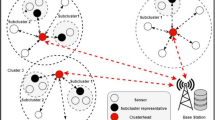Abstract
Denial of Service (DoS) attack is a serious threat to the security of Wireless Sensor Netwokr (WSN). Moreover, Reduce of Quality (RoQ) attack is a special DoS attack type. The RoQ attack is a potential DoS attack, it is simulator to normal traffic,so it is difficult to be detected by traditional detection method. Hilbert–Huang Transform (HHT) time–frequency analysis method can be used to analyze the non-linear signal generated by RoQ attack. However, mode mixing and false component are the challenge problems to analyze the RoQ attack by HHT method. Ensemble empirical mode decomposition (EEMD) method is used to eliminate the mode mixing problem. Correlated coefficient method is used to recognize the false components. In this paper, EEMD and correlated coefficient methods are combined to detect the weak signal generated by RoQ attack. Ad Hoc On-demand Multi-path Distance Vector routing protocol and random Routing REQuest flooding attack are simulated to implement RoQ attack in wireless sensor network by Network Simulator. Suitable white noises are added to original signal to detect the weak RoQ attack signal. Experiment results show that the improved HHT methods are highly effective to detect RoQ attack, when the standard deviation of white noise is 0.01 and the number of ensemble is 80, the detection results is best. When the correlated coefficient of intrinsic mode functions (IMFs) is greater than 0.2, the IMFs can be used to analyze and detect RoQ attack. To our knowledge, this is the first quantitative experiment and method research on the routing-layer RoQ attack detection in WSN.


















Similar content being viewed by others
References
Krishna Chaitanya, D., Ghosh, A., & Ever, E. (2011). Analysis of denial of service attacks on wireless sensor networks using simulation. In Kaspersky Lab IT security conference for the next generation, Erfurt, Germany, January 27–30.
He, Y.et al. (2009). Reduction of Quality (RoQ) attacks on structured peer-to-peer networks. In IEEE international parallel and distributed processing symposium (IPDPS 09).
Guirguis, M., Bestavros, A., Matta, I., & Zhang, Y. (2005). Reduction of Quality (RoQ) attacks on internet end- systems. IEEE INFOCOM, 2, 1362–1372.
Chen, W., Zhang, Y., & Wei, Y. (2008). The feasibility of launching Reduction of Quality (RoQ) attacks in 802.11 wireless networks. In International conference on parallel and distributed systems - ICPADS 2008 (pp. 517–524).
Barros, U., Bouet, M., Santos, T. A., & Nogueira, M. (2010). Assessing RoQ attacks on MANETs over aware and unaware TPC techniques. In 2010 International conference on network and service management (pp. 1–5).
Ren, W., Yeung, D.-Y., & Jin, H. (2007). Pulsing RoQ DDoS attack and defense scheme in mobile ad hoc networks. International Journal of Network Security, 4(2), 227–234.
Wen, K., Yang, J., Cheng, F., Li, C., Wang, Z., & Yin, H. (2014). Two-stage detection algorithm for RoQ attack based on localized periodicity analysis of traffic anomaly. In ICCCN, 2014 (pp. 1–6).
Hong, R., Hui-Mei, W., & Ming, X. (2013). A novel method for detecting Reduction of Quality (RoQ) attack based on fast independent component analysis. Journal of Electronics & Information Technology, 35(10), 2307–2313.
Torrence, C., & Compo, G. (1998). A practical guide to wavelet analysis. Bulletin of the American Meteorological Society, 79(1), 61–78.
Huang, N. E., Shen, Z., & Long, S. R. (1998). The empirical ode decomposition and the Hilbert spectrum for nonlinear and non-stationary time series analysis. Proceedings of the Royal Society of London A, 454, 903–995.
Kangfeng, Z., Xiujuan, W., Yixian, Y., & Shize, G. (2011). Detecting DDoS attack With Hilbert–Huang transformation. China Communications, 8(2), 126–133.
Han, J., & Zhang, J. Z. (2013). Network traffic anomaly detection using weighted self-similarity based on EMD. In 2013 Proceedings of IEEE Southeastcon, Southeastcon (pp. 1–5).
Han, J. (2013). Network traffic anomaly detection using EMD and Hilbert-Huan transform. 2013 Western Carolina University (WCU) Thesis.
Le, A., & Loo, J. (2013). The impact of rank attack on network topology of routing protocol for low-power and lossy networks. IEEE Sensors Journal, 13(10), 3685–3692.
Hsueh, C.-T., & Wen, Chih-Yu. (2015). A secure scheme against power exhausting attacks in hierarchical wireless sensor networks. IEEE Sensors Journal, 15(6), 3590–3602.
Shiravi, A., Shiravi, H., Tavallaee, M., & Ghorbani, A. A. (2012). Toward developing a systematic approach to generate benchmark datasets for intrusion detection. Computers & Security, 31(3), 357–374.
Hamedheidari, S., & Rafeh, R. (2013). A novel agent-based approach to detect sinkhole attacks in wireless sensor networks. Computers & Security, 37(20), 1–14.
Hongsong, C., Zhenzhou, J., & Mingzeng, H. (2007). Design and performance evaluation of a multi-agent-based dynamic lifetime security scheme for AODV routing protocol. Journal of Network & Computer Applications, 30(1), 145–166.
Huang, N. E., Shen, Z., & Long, S. R. (1999). A new view of nonlinear water waves: The Hilbert spectrum. Annual Review of Fluid Mechanics, 31, 417–457.
Wu, Z., & Huang, N. E. (2009). Ensemble empirical mode decomposition: A noise-assisted data analysis method. Advances in Adaptive Data Analysis, 1, 1–41.
http://www.isi.edu/nsnam/ns. Accessed Jan 2017.
Zhang, W., Wang, C., & Wang, H. (2012). Hilbert–Huang transform-based electrostatic signal analysis of ring-shape electrodes with different widths. IEEE Instrumentation and Measurement Society, 64(5), 1209–1217.
Wang, L., Yan, Y., Hu, Y., & Qian, X. (2014). Rotational speed measurement through electrostatic sensing and correlation signal processing. IEEE Transactions on Instrumentation and Measurement, 63(5), 1190–1199.
Chen, H., Bhargava, B., & Zhongchuan, F. (2014). Multilabels-based scalable access control for big data applications. IEEE Cloud Computing Magazine, 1(3), 65–71.
Acknowledgements
This work was supported by National Key Research and Development Program of China (2018YFB0803403, 2018YFB0803400). National Social Science Fund of China (18BGJ071). Fundamental Research Funds for the Central Universities (TW201706). Beijing Natural Science Foundation (4142034).
Author information
Authors and Affiliations
Corresponding author
Additional information
Publisher's Note
Springer Nature remains neutral with regard to jurisdictional claims in published maps and institutional affiliations.
Rights and permissions
About this article
Cite this article
Chen, H., Liu, M. & Zhongchuan, F. Using Improved Hilbert–Huang Transformation Method to Detect Routing-Layer Reduce of Quality Attack in Wireless Sensor Network. Wireless Pers Commun 104, 595–615 (2019). https://doi.org/10.1007/s11277-018-6036-3
Published:
Issue Date:
DOI: https://doi.org/10.1007/s11277-018-6036-3




